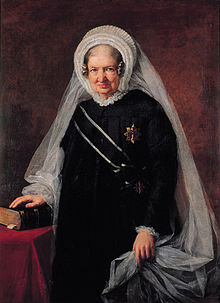Luise von Schierstedt
Luise von Schierstedt (born December 26, 1794 ; † August 23, 1876 in Heiligengrabe ) was abbess of the Protestant women's monastery, Stift zum Heiligengrabe , Brandenburg , from 1843 to 1876 .
Life

Luise von Schierstedt was the daughter of the district president of Neumark . She had eight siblings. Her father died in 1811. In 1819 she was accepted into the women's monastery in Heiligengrabe after one of her three sisters, who had belonged to the monastery, died. In 1822 she was given a full post, but initially did not live permanently in Heiligengrabe. Her mother died in 1828; two years later, Luise finally moved into the women's pen.
Abbess Henriette Wilhelmine Elisabeth von Steinwehr (* 1768) died in 1843 . Luise von Schierstedt was elected her successor despite opposition from the convention. It set itself the goal of the reorganization of the monastery operated by the Prussian King Friedrich Wilhelm IV . He rejected the enlightenment efforts of Henriette von Steinwehr and the convent. Although he wanted to promote the education and employment of women, he relied on decent activities such as that of deaconesses . He saw the noble ladies' pencils as suitable to support the wishes of the authorities. Luise von Schierstedt shared his view and wanted to found a collegiate school, a hospital and other charitable institutions in his spirit.
Luise von Schierstedt spent so much in the resistance against the convention, which did not want to allow itself to be co-opted by the state, that her health suffered and in August 1846 she began a recreational stay in Baden-Baden . After their return, the educational institution was founded in 1847 to provide daughters from impoverished aristocratic families with adequate education. You should just, but her station according to be educated, and after eight years of schooling after the confirmation to be able to take a position (...) that secures their existence .
The conflicts between the abbess and the convent continued, so that Luise von Schierstedt wanted to renounce the office of abbess in 1849. It didn't come to that; the statutes of the monastery were revised and from 1853 a distinction was made between members of the monastery between supply points for female nobles and positions for working women . In 1863 she presented her report on the reorganization of the monastery to Friedrich Wilhelm IV.
Her favorite student was Paula von Wedell . In 1876 she received a certificate from Elise Averdieck , founder of the Rothenburg and Hamburg Deaconess House Bethesda, which said: Miss Paula von Wedell has been a member of the Sisterhood of the Deaconesses and Sanatorium Bethesda for 2 years. Through faithful, obedient work and work in the care of the sick, poor, children and the elderly, she prepares herself to serve the Lord in our Bethesda for His poor and weak as a blessed deaconess.
Luise von Schierstedt died in 1876. She was buried in the monastery cemetery.
literature
- Luise von Schierstedt in Lifetime Achievements - Women in Kloster Stift Heiligengrabe between 1847 and 1945 Kloster Stift zum Heiligengrabe (Simone Oelker, Astrid Reuter) (Ed.) Monuments, publications of the German Foundation for Monument Protection, Bonn 2002, p. 28f. ISBN 3-935208-19-7
- Werner von Kieckebusch: Chronicle of the monastery of the Holy Grave from the Reformation to the middle of the 20th century , ed. by Brigitte Müller-Bülow on Dohna / Gabriele Simmermacher, Berlin 2008.
Individual evidence
- ↑ Ursula Röper: When a woman learned to read, the question of women came into the world. in: Lifetime Achievements - Women in the Stift Heiligengrabe Monastery between 1847 and 1945 page 23
- ↑ Ursula Röper: When a woman learned to read, the question of women came into the world. in: Lifetime Achievements - Women in the Kloster Heiligengrabe Monastery between 1847 and 1945, pages 24 and 25
| personal data | |
|---|---|
| SURNAME | Schierstedt, Luise von |
| ALTERNATIVE NAMES | Schierstedt, Louise von |
| BRIEF DESCRIPTION | German abbess |
| DATE OF BIRTH | December 26, 1794 |
| DATE OF DEATH | August 23, 1876 |
| Place of death | Holy grave |